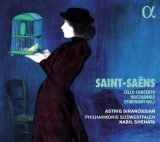Ein berückendes Cantando im Allegretto con moto, in perfektem Puls drängende Virtuosität in den Ecksätzen: Astrig Siranossian schöpft mit voller Kelle im Notenmaterial von Camille Saint-Saëns, kostet mit intensiver Gestik die bezaubernde Höhe ihres Instruments ebenso aus wie die wohlig schnurrende Tiefe. Doch wenn mir diese Interpretation im Gedächtnis bleiben wird, dann wohl vor allem wegen des Mittelsatzes: so tief empfunden, so schön, so warmherzig hört man diese Musik nicht oft.
Die Ecksätze sind freilich auch bestens gelungen, da sowohl die Solistin als auch der deutsch-ägyptische Dirigent Nabil Shehata auf einen leichten und transparenten Klang ohne jedes Pathos, dafür aber umso mehr beseelter Rhetorik setzen.
Shehata dirigiert auch eine gute, ausdrucksvolle Interpretation der Ersten Symphonie und der Bacchanale, wobei die Philharmonie Südwestfalen mit engagiertem und technisch gutem Spiel auf sein Dirigat antwortet.
An enchanting cantando in the Allegretto con moto, alert virtuosity and perfect pulse in the corner movements: Astrig Siranossian draws with her full ladle from the score of Camille Saint-Saëns, tasting with intense gestures the enchanting high notes of her instrument as well as the pleasantly purring low register. But if this interpretation will remain in my memory, it is probably above all because of the middle movement: one does not often hear this music so deeply felt, so beautiful, so warm-hearted.
The other movements are also very successful, since both the soloist and the German-Egyptian conductor Nabil Shehata rely on a light and transparent sound without any pathos, but all the more soulful rhetoric.
Shehata also conducts a good, expressive interpretation of the First Symphony and the Bacchanale, with the Philharmonie Südwestfalen responding to his conducting with committed and technically good playing.






















